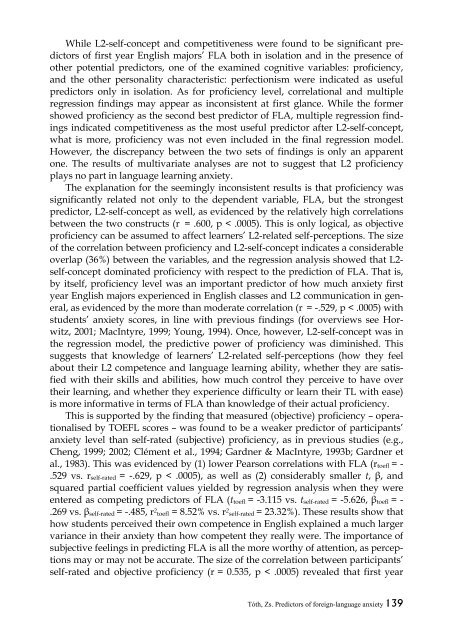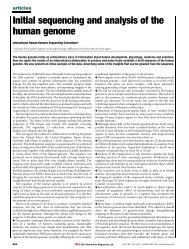Predictors of Foreign-Language Anxiety: Examining the ...
Predictors of Foreign-Language Anxiety: Examining the ...
Predictors of Foreign-Language Anxiety: Examining the ...
Create successful ePaper yourself
Turn your PDF publications into a flip-book with our unique Google optimized e-Paper software.
While L2-self-concept and competitiveness were found to be significant predictors<strong>of</strong> first year English majors’ FLA both in isolation and in <strong>the</strong> presence <strong>of</strong>o<strong>the</strong>r potential predictors, one <strong>of</strong> <strong>the</strong> examined cognitive variables: pr<strong>of</strong>iciency,and <strong>the</strong> o<strong>the</strong>r personality characteristic: perfectionism were indicated as usefulpredictors only in isolation. As for pr<strong>of</strong>iciency level, correlational and multipleregression findings may appear as inconsistent at first glance. While <strong>the</strong> formershowed pr<strong>of</strong>iciency as <strong>the</strong> second best predictor <strong>of</strong> FLA, multiple regression findingsindicated competitiveness as <strong>the</strong> most useful predictor after L2-self-concept,what is more, pr<strong>of</strong>iciency was not even included in <strong>the</strong> final regression model.However, <strong>the</strong> discrepancy between <strong>the</strong> two sets <strong>of</strong> findings is only an apparentone. The results <strong>of</strong> multivariate analyses are not to suggest that L2 pr<strong>of</strong>iciencyplays no part in language learning anxiety.The explanation for <strong>the</strong> seemingly inconsistent results is that pr<strong>of</strong>iciency wassignificantly related not only to <strong>the</strong> dependent variable, FLA, but <strong>the</strong> strongestpredictor, L2-self-concept as well, as evidenced by <strong>the</strong> relatively high correlationsbetween <strong>the</strong> two constructs (r = .600, p < .0005). This is only logical, as objectivepr<strong>of</strong>iciency can be assumed to affect learners’ L2-related self-perceptions. The size<strong>of</strong> <strong>the</strong> correlation between pr<strong>of</strong>iciency and L2-self-concept indicates a considerableoverlap (36%) between <strong>the</strong> variables, and <strong>the</strong> regression analysis showed that L2-self-concept dominated pr<strong>of</strong>iciency with respect to <strong>the</strong> prediction <strong>of</strong> FLA. That is,by itself, pr<strong>of</strong>iciency level was an important predictor <strong>of</strong> how much anxiety firstyear English majors experienced in English classes and L2 communication in general,as evidenced by <strong>the</strong> more than moderate correlation (r = -.529, p < .0005) withstudents’ anxiety scores, in line with previous findings (for overviews see Horwitz,2001; MacIntyre, 1999; Young, 1994). Once, however, L2-self-concept was in<strong>the</strong> regression model, <strong>the</strong> predictive power <strong>of</strong> pr<strong>of</strong>iciency was diminished. Thissuggests that knowledge <strong>of</strong> learners’ L2-related self-perceptions (how <strong>the</strong>y feelabout <strong>the</strong>ir L2 competence and language learning ability, whe<strong>the</strong>r <strong>the</strong>y are satisfiedwith <strong>the</strong>ir skills and abilities, how much control <strong>the</strong>y perceive to have over<strong>the</strong>ir learning, and whe<strong>the</strong>r <strong>the</strong>y experience difficulty or learn <strong>the</strong>ir TL with ease)is more informative in terms <strong>of</strong> FLA than knowledge <strong>of</strong> <strong>the</strong>ir actual pr<strong>of</strong>iciency.This is supported by <strong>the</strong> finding that measured (objective) pr<strong>of</strong>iciency – operationalisedby TOEFL scores – was found to be a weaker predictor <strong>of</strong> participants’anxiety level than self-rated (subjective) pr<strong>of</strong>iciency, as in previous studies (e.g.,Cheng, 1999; 2002; Clément et al., 1994; Gardner & MacIntyre, 1993b; Gardner etal., 1983). This was evidenced by (1) lower Pearson correlations with FLA (r toefl = -.529 vs. r self-rated = -.629, p < .0005), as well as (2) considerably smaller t, β, andsquared partial coefficient values yielded by regression analysis when <strong>the</strong>y wereentered as competing predictors <strong>of</strong> FLA (t toefl = -3.115 vs. t self-rated = -5.626, β toefl = -.269 vs. β self-rated = -.485, r 2 toefl = 8.52% vs. r 2 self-rated = 23.32%). These results show thathow students perceived <strong>the</strong>ir own competence in English explained a much largervariance in <strong>the</strong>ir anxiety than how competent <strong>the</strong>y really were. The importance <strong>of</strong>subjective feelings in predicting FLA is all <strong>the</strong> more worthy <strong>of</strong> attention, as perceptionsmay or may not be accurate. The size <strong>of</strong> <strong>the</strong> correlation between participants’self-rated and objective pr<strong>of</strong>iciency (r = 0.535, p < .0005) revealed that first yearTóth, Zs. <strong>Predictors</strong> <strong>of</strong> foreign-language anxiety 139
















